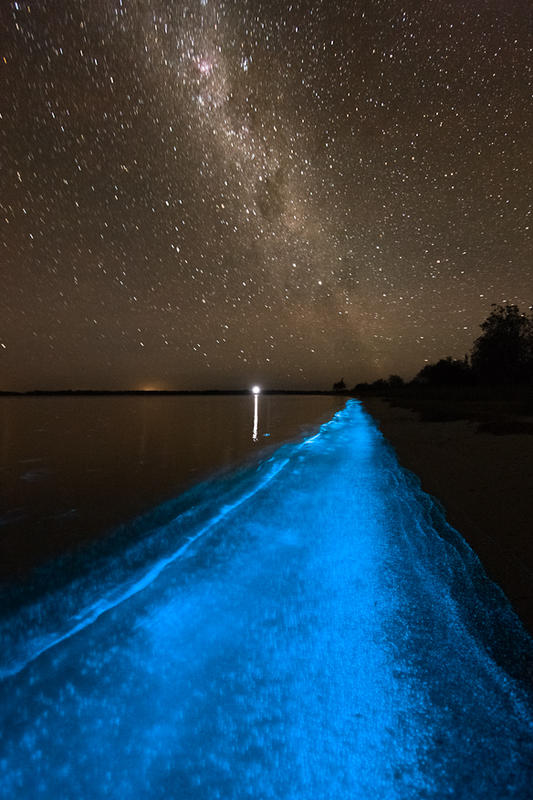Adaptation
 Noctiluca scintillans is a bioluminescent organism. This
organism is fairly well known for the beautiful light show it puts
on in the
sea. It is more commonly known as the sea sparkle because
of the bluish light that can be seen “sparkling” in the ocean at
night. Unlike some other bioluminescent organisms that rely on
bacteria, Noctiluca scintillans has a luciferin-luciferase
chemical reaction within the cell that gives this organism the
bioluminescent quality (Oceana 2013).
Noctiluca scintillans is a bioluminescent organism. This
organism is fairly well known for the beautiful light show it puts
on in the
sea. It is more commonly known as the sea sparkle because
of the bluish light that can be seen “sparkling” in the ocean at
night. Unlike some other bioluminescent organisms that rely on
bacteria, Noctiluca scintillans has a luciferin-luciferase
chemical reaction within the cell that gives this organism the
bioluminescent quality (Oceana 2013).
The luciferin-luciferase reaction is very similar to the
reaction seen in fireflies when they light up. However, unlike
fireflies, that use this characteristic as a form of a mating call,
Noctiluca scintillans are thought to use this
bioluminescence as a
defense mechanism (Buskey et al. 1992). One
theory is that if there are predators near, Noctiluca
scintillans lights up and creates the sparkling effect that
they are so well known for. The light attracts larger predators that
aren’t interested in eating Noctiluca scintillans; these
predators eat or scare away the smaller predators that would
normally feed on Noctiluca scintillans. It is also thought
that the light may just startle the predator and scare them away
(Valiadi et al. 2012). Noctiluca scinitllans is just one of
many bioluminescent organisms including
Kryptophanaron alfredi
and
Photinus ignitus.
 Noctiluca scintillans cannot swim; they float with the
current (Fukuda and Endoh 2006). Unlike most dinoflagellates,
Noctiluca scintillans has only one flagellum, where most have
two. It also has a tentacle that is much larger and more noticeable
than the flagellum. The tentacle is used to collect food (Kiorboe
and Titelman 1998).
Noctiluca scintillans cannot swim; they float with the
current (Fukuda and Endoh 2006). Unlike most dinoflagellates,
Noctiluca scintillans has only one flagellum, where most have
two. It also has a tentacle that is much larger and more noticeable
than the flagellum. The tentacle is used to collect food (Kiorboe
and Titelman 1998).
Because Noctiluca scintillans and their prey are both
immotile, they need a way to sense and capture their prey. They use
their tentacle for this purpose. Sometimes, they will have a string
of mucus attached to the end of their tentacle that aids them in
sensing and capturing prey. Their prey may either hit the tentacle
directly and be brought into the oral cavity or it may become
trapped in the string of mucus, which is then rolled up into the
oral cavity (Kiorboe and Titelman 1998).
Noctiluca scintillans is a positively buoyant
organism. They are less dense than seawater, so they float near the
surface. They are able to control their buoyancy by adjusting
concentrations within the cell (Oceana 2012). This helps them ascend
slightly deeper into the water to capture prey. You can learn more
about the buoyancy of Noctiluca scintillans in the
Interactions page.
Now that you better understand the form and function of Noctiluca
scintillans, you are able to learn more about this dinoflagellate's
Reproduction. If you would like to start fresh on this website,
please visit the
Homepage.